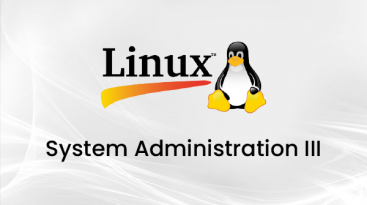Overview
"Linux System Administration III" training for participants, setting up, configuring and managing network servers using services such as Caching Domain Name Service (DNS), MariaDB, Apache HTTPD, Postfix SMTP, Network File System (NFS) and Server Message Block (SMB). focuses on sharing files on the network using network, sharing and using iSCSI block devices as remote disks, configuring advanced networking and firewall configurations, automating processes on the system, and finally using Bash shell scripting.
Duration 4 days.
You can find current trainings on training calendar page.
Training Prerequisites
Linux Sistem Yönetimi I ve Linux Sistem Yönetimi II eğitimini tamamlamış olmak önkoşulu bulunmaktadır.
Training Contents
- Audit services and daemons
Management of services and boot-up operations using systemctl
- IPv6 network management
Configuring the basic IPv6 network and troubleshooting in Linux systems
- Configure link aggregation and bridging
Configure and troubleshoot advanced network interface functionality including bonding, teaming, and local software bridges
- Control network port security
Operations to allow or deny access to network services using advanced SELinux and Firewalld (Firewall) filtering techniques
- DNS management
Setting up and verifying the correct DNS records for Linux systems and secure (caching) DNS caching configuration processes
- E-mail delivery configuration
Relay all email sent by the system to an SMTP gateway for central delivery
- Provide Block-Based storage
Operations to provision and use network-based iSCSI block devices as remote disks
- Provide file-based storage
Operations to provide file sharing with NFS and SMB to specific systems and users
- MariaDB database configuration
MariaDB SQL database configuration processes for use by programs and database administrators
- Apache HTTPD Web Service configuration
Configuring the Apache HTTPD service using the Transport Layer Security (TLS) protocol to provide websites and virtual hosts
- Writing Bash Scripting
Writing simple shell scripts using bash
- Comprehensive review and sampling
Using many examples to apply the knowledge and skills learned in this training
Training Objectives
“Linux System Administration III” training provides for the participants to set up, configure and manage network servers using services such as Caching Domain Name Service (DNS), MariaDB, Apache HTTPD, Postfix SMTP, Network File System (NFS) and Server Message Block (SMB) services. It focuses on sharing files on the network using iSCSI block devices, sharing and using iSCSI block devices as remote disks, configuring advanced networking and firewall configurations, automating and configuring operations on the system, and finally using Bash shell scripting.
Who should attend?
This training is designed for experienced Linux system administrators who want to expand their ability to manage Linux systems at the enterprise level. It is recommended that the barriers who will participate in this training should have completed the "Linux System Administration I and II" trainings, which are Linux entry and intermediate level trainings.
- Overview
- Prerequisites
- Contents
- Objectives
- Audience
Overview
"Linux System Administration III" training for participants, setting up, configuring and managing network servers using services such as Caching Domain Name Service (DNS), MariaDB, Apache HTTPD, Postfix SMTP, Network File System (NFS) and Server Message Block (SMB). focuses on sharing files on the network using network, sharing and using iSCSI block devices as remote disks, configuring advanced networking and firewall configurations, automating processes on the system, and finally using Bash shell scripting.
Duration 4 days.
You can find current trainings on training calendar page.
Training Prerequisites
Linux Sistem Yönetimi I ve Linux Sistem Yönetimi II eğitimini tamamlamış olmak önkoşulu bulunmaktadır.
Training Contents
- Audit services and daemons
Management of services and boot-up operations using systemctl
- IPv6 network management
Configuring the basic IPv6 network and troubleshooting in Linux systems
- Configure link aggregation and bridging
Configure and troubleshoot advanced network interface functionality including bonding, teaming, and local software bridges
- Control network port security
Operations to allow or deny access to network services using advanced SELinux and Firewalld (Firewall) filtering techniques
- DNS management
Setting up and verifying the correct DNS records for Linux systems and secure (caching) DNS caching configuration processes
- E-mail delivery configuration
Relay all email sent by the system to an SMTP gateway for central delivery
- Provide Block-Based storage
Operations to provision and use network-based iSCSI block devices as remote disks
- Provide file-based storage
Operations to provide file sharing with NFS and SMB to specific systems and users
- MariaDB database configuration
MariaDB SQL database configuration processes for use by programs and database administrators
- Apache HTTPD Web Service configuration
Configuring the Apache HTTPD service using the Transport Layer Security (TLS) protocol to provide websites and virtual hosts
- Writing Bash Scripting
Writing simple shell scripts using bash
- Comprehensive review and sampling
Using many examples to apply the knowledge and skills learned in this training
Training Objectives
“Linux System Administration III” training provides for the participants to set up, configure and manage network servers using services such as Caching Domain Name Service (DNS), MariaDB, Apache HTTPD, Postfix SMTP, Network File System (NFS) and Server Message Block (SMB) services. It focuses on sharing files on the network using iSCSI block devices, sharing and using iSCSI block devices as remote disks, configuring advanced networking and firewall configurations, automating and configuring operations on the system, and finally using Bash shell scripting.
Who should attend?
This training is designed for experienced Linux system administrators who want to expand their ability to manage Linux systems at the enterprise level. It is recommended that the barriers who will participate in this training should have completed the "Linux System Administration I and II" trainings, which are Linux entry and intermediate level trainings.




